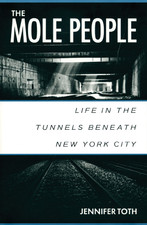 As much as I love reading, most of my time is dedicated to textbooks as I unwisely earn degree after degree. One book that I was able to sneak in that has haunted me ever since is The Mole People: Life in the Tunnels beneath New York City by Jennifer Toth (1993). The author takes us on an unsettling journey deep into the abandoned tunnels of the New York City train stations to prove the urban legend true: that muthafuckas are living below the platforms. Can this be? How do they survive down there? Are they eyeless like actual moles? I’m not a fan of going to work; can I live down there too? These riveting questions must be answered.
As much as I love reading, most of my time is dedicated to textbooks as I unwisely earn degree after degree. One book that I was able to sneak in that has haunted me ever since is The Mole People: Life in the Tunnels beneath New York City by Jennifer Toth (1993). The author takes us on an unsettling journey deep into the abandoned tunnels of the New York City train stations to prove the urban legend true: that muthafuckas are living below the platforms. Can this be? How do they survive down there? Are they eyeless like actual moles? I’m not a fan of going to work; can I live down there too? These riveting questions must be answered.
Being a New York City enthusiast, I wanted to learn more about the mole people. I rode the subway most of my life and would often stare out the window into the tunnel’s dark abyss wondering if someone was out there. To my horror, Toth estimates about 4,000 people were living in the catacombs under Grand Central Station and Penn Station during the 1990s. As she ventures down several layers below the platform with her tunnel guide “Blade,” we’re introduced to all sorts of derelicts and learn their twisted stories. She discovers a society of outcasts made up of addicts, runaways, mentally ill and disenfranchised people who have forged their own community in the tunnels.
Many of the interviewed inhabitants believe they were marginalized and pushed into life below the surface. With the cost of living so high in New York City they would rather live in a tunnel rent-free. Robbery and rape in homeless shelters force people to seek a safe haven elsewhere. However, danger, disease, and addiction are some of the everyday issues the homeless experience in the tunnels. They are terrorized by gangs, hassled by police, and preyed upon in Darwinian fashion.
Not all is grim down below. They shower in running water from broken pipes, cook on open fires and hook up televisions to electrical wires. They have their own education, legal, and healthcare systems, and even have a mayor. You need permission from Mayor Bernard Isaacs to live in these tunnels! The “runner’s” role is to return to the surface to retrieve food, medicine, and supplies. They refer to those who live above ground as “surface dwellers.” Some mole people have dogs and cats as pets. These animals actually have a better gig than the ones in those damn Sarah McLaughlin commercials.
Although this book includes photographic proof of life in the tunnels and sites specific locations, critics argue much of the book is inaccurate and the stories are impossible to confirm. Toth’s most outspoken critic, Joseph Brennan, sketched and uploaded maps of the stations on his website Abandoned Stations where he disputes much of her geography. Factual or not, the book contains truths about the homeless that make us uncomfortable. Our social system is failing those who truly need it. The demons that plague them combined with our unsympathetic judgment and perhaps fear and guilt towards the homeless have caused them to find refuge in this underground metropolis. Who’s to say that there is no possibility of turning out like them?
The book’s end wraps up quite conveniently. Word on the street is that “Blade” is out to kill Toth so she flees across country. As tempting as it is to escape the obligations of every day life, I prefer my surface dweller status. Mankind needs rules, daylight, and to not get stabbed. Also, check out Marc Singer’s documentary Dark Days on people living in Amtrak tunnels.
